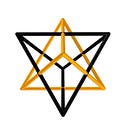A Philosophical Investigation
In the Wittgensteinian Tradition
Once upon a time, a seafaring tribe, the Trims, were into fishing, sailing, and weaving nets.
They had a specific way of multiplying, passed down from one generation to the next.
“Three by five” would mean the surface area between two edges of length three and five, with a sixty degree angle between them. The resulting area: fifteen triangular units.
Or take “six by two” as shown below. The units of area are the small triangles at any corner. They tile the entire surface.
The green triangle consists of an area equal to twelve of these units. The two edges emanate from the lower right corner to define this “two by six” or “six by two” green triangle.
“Two by two by five” would describe three edges of a volume, again with sixty degree angles between them, each emanating from the same corner of a regular tetrahedron.
The resulting volume is two times two times five, or twenty tetrahedral units.
The unit volumes are visible at the tips. These tetrahedrons alternate with octahedrons of volume four to…
